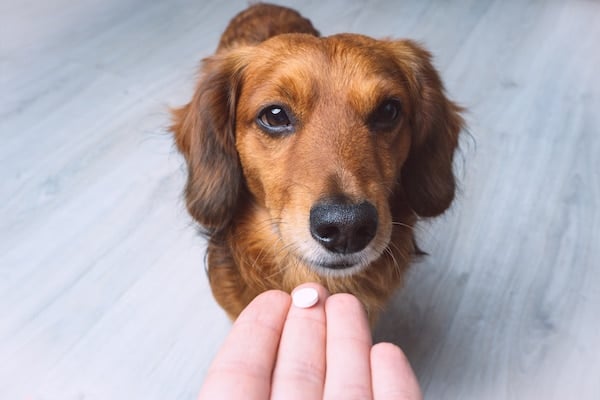- This post contains affiliate links. Read more here.
- Not a substitute for professional veterinary help.
We would do anything for our pets, which is why it can be so heartbreaking to watch them struggle with stress and fear. We might know that the thunder will pass, the fireworks are no real danger, or a vet visit is for their own good—but they don’t. Cue sad whines, shaky limbs, and a whole host of other anxious responses.
In your quest to find ways to soothe your pet’s fear, you’ve probably come across dog calming collars. You might have also seen the mixed reviews and wondered if these tools are actually effective in soothing a dog’s stress. To learn more about these calming devices, including both how and whether they work, we consulted veterinarians and tested some collars ourselves.
How Do Dog Calming Collars Work?
If you’ve ever lit a candle to help yourself relax, you already know a bit about dog calming collars. These pet-specific devices function like aromatherapy does for humans. Except while some collars do rely on purely scent-based treatments, they often go a step further with chemicals called pheromones.
How Pheromones Calm Pets
Pheromones are natural chemicals produced by both animals and insects. When pheromones are released from the body, they’re picked up by other animals through the nose. There’s still a lot to learn on the topic, but pheromones seem to have whole host of purposes in the animal kingdom. This includes attracting a mate, encouraging young animals to eat, and even choreographing the activity of a bee hive.
Scientists are pretty sure that they’re species-specific, meaning that humans are not receptive to the same pheromones as our pets.
Dog calming collars typically contain a synthetic version of a natural hormone called a dog-appeasing pheromone or DAP. “This pheromone is released as mother dogs nurse their puppies very early in life,” says Joseph Turk, D.V.M., a veterinarian in Palm Harbor, Florida. “As such, it appears to aid in relaxation for some dogs.”
One study found that dogs who were exposed to pheromones were noticeably less anxious in a veterinary hospital. Another examined pheromones’ effect on beagles, noting that the dogs were less nervous during simulated thunderstorms.

FatCamera via iStock
Essential Oil Dog Calming Collars
While pheromones are commonly used in dog calming collars, another option is an herbal or essential oil collar. These collars rely on the same aromatherapy effects that humans frequently use to relax. Lavender, a naturally calming scent, is frequently found in natural calming collars.
When considering an essential oil product, pet parents should review their options thoroughly, as some essential oils are toxic to pets. If your dog shares a space with cats, you’ll want to be extra careful about using essential oils. Cats are even more sensitive to the risks of essential oils than dogs—and lavender, while dog-friendly, is not considered safe for our feline friends.
When To Use a Calming Collar
Much like humans, dogs of all breeds can experience anxiety. Common symptoms of dog anxiety include unusual aggression, panting, destructive behavior, pacing, and restlessness.
While there are several methods to address anxiety in dogs, some trial and error may be needed to find the one—or, very likely, the combination—that works best for your pet. Training, desensitization, and even medication are often prescribed to reduce mild to severe anxiety in dogs. Pressure wraps, diffusers, and, of course, dog calming collars are additional tools to have in your soothing toolkit, and may be used alone or along with other techniques.
What the Experts Say About Dog Calming Collars
Especially after our own results weren’t particularly successful, we wanted to know what the experts said about dog calming collars. The consensus was cautiously optimistic—and depends strongly on the particular dog.
“I’ve seen success with calming pheromone collars and diffusers in dog patients exhibiting anxiety (firework, thunderstorm, separation, etc.), inappropriate urination/defecation, aggressive tendencies, and more,” says Patrick Mahaney, V.M.D., a veterinarian in Los Angeles.
Dr. Turk has seen results at both ends of the effectiveness spectrum. “Sometimes we have good results with these collars, and sometimes there can be little to no difference noted.”
He adds that it could be related to the severity of the dog’s anxiety, and Dr. Simon agrees. “Collars work best for those who are mildly anxious and who need minimal external help. For a dog with severe anxiety, a collar is not likely to have much effect,” she says. “These dogs generally require prescribed anxiolytic medicine and behavioral modification programs.”

Daria Kulkova via iStock
To determine whether a calming collar is working for your dog, Dr. Mahaney and Dr. Turk both encourage pet parents to carefully track their pet’s behavior.
“Create a treatment log/journal by noting the dog’s response (improved, worsened, no change, etc.) on a calendar,” says Dr. Mahaney. In addition, Dr. Turk recommends filming your dog as well—an easy charge for most doting dog parents. This establishes objective evidence for you and your vet to review.
While not every pet parent will get the results they hope from a dog calming collar, they’re often a relatively affordable first stop on the journey to combat a pet’s anxiety and a good place to start. Dr. Simon points out that the collars are generally considered quite safe, and they don’t have the potential for uncomfortable side effects like medications and even some soothing treats.
“The only negative consequence I’ve ever observed was a dog who ate one of the collars and had gastrointestinal issues,” Dr. Turk notes. Dr. Simon recommends trimming any excess length from the collar after fitting it to your dog to prevent exactly that issue.
If a calming collar doesn’t work, it can be a good indication that more serious intervention is needed.
The Most Popular Calming Collars on the Market
One of the challenges of choosing a dog calming collar for your pup is the lack of consensus in reviews. Whether you’re seeking a pheromone- or essential-oil- based collar for your dog, you’ll likely find that results vary—as we did in our testing.
Dr. Linda Simon, a veterinary surgeon and consultant for the website FiveBarks, often recommends the Adaptil Adjustable Calming Collar for her anxious patients. Popular for use with loud noises, training, kennel time, and socialization, the DAP-infused collar is also safe to use with flea and tick topical medications. Our reviewer didn’t see a remarkable difference in their dog’s behavior when using the collar but suspects that their dog’s high anxiety might have been too much for it to help.
Another popular pheromone-based collar comes from the makers of Thundershirt, a highly regarded pressure wrap for anxious dogs. The ThunderEase Calming Dog Collar can be useful for stress chewing, problem barking, and separation anxiety. Our test reviewer had trouble getting the rubber collar to comfortably fit their greyhound’s long, skinny neck, but other reviewers praised its effects.

Oscar the Rover test pup continues to see small improvements with his ThunderShirt.
For a double punch of calm, the Sentry Calming Collar for Dogs uses both pheromones and aromatherapy, containing soothing lavender and chamomile. Lasting up to 30 days, it’s designed to help with loud noises like thunderstorms and fireworks as well as travel and separation anxiety. In the collar’s reviews, many pet parents particularly noted its pleasant scent.
Final Verdict: Do Dog Calming Collars Work?
So do dog calming collars work? The evidence is clear that calming collars may work for some dogs. But both the reviews and expert opinions make it clear they’re not a guaranteed win for all or even most pups. If you don’t mind shelling out a few dollars on the experiment, however, it is possible to see a reduction in your dog’s anxious behaviors.
Calming collars may work best for:
- Dogs with mild anxiety
- Situations where the collar is one of a number of calming tools being utilized
Calming collars are unlikely to help:
- Dogs with severe anxiety
- Creative chewers who will find a way to eat the collar
If calming collars don’t interest you or they simply don’t work for your dog, you might try one of these alternatives to soothe your pet:
- A compression wrap like the Thundershirt, which wraps your dog in hug-like pressure
- Dog calming treats, offered as-needed or daily to regulate moods
- Pheromone sprays or diffusers, which deliver soothing pheromones in another way
- Puzzle toys and snuffle mats to focus your pup’s mind on something other than their fear
If you’re concerned about your pet’s level of fear or anxiety, it’s always a good idea to reach out to your vet. They can help you focus in on products, behavioral adjustments, and even medications to meet your dog’s specific needs.
How We Chose
The calming collars featured here were selected based on a combination of our own hands-on testing, a comprehensive look at customer reviews across a wide variety of retail platforms, and interviews with our veterinary experts. For these collars, we prioritized positive reviews and first-hand experience, looking for the most promising options in a challenging product field. As always, our selections are guided by our experience living with our own pets, both anxious and calm.





